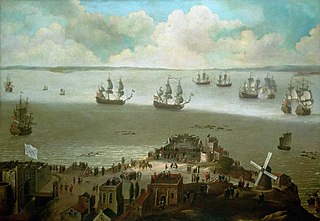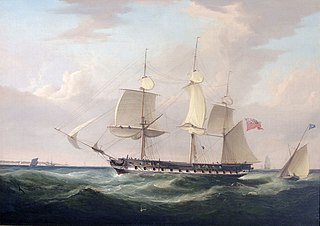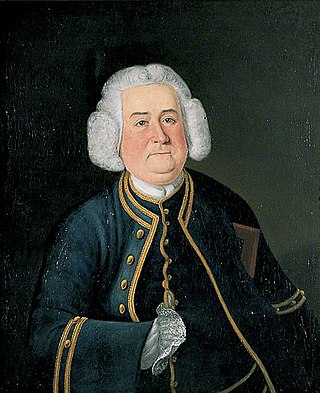
The Luxborough Galley was an English ship owned by the South Sea Company which in 1727 burnt, exploded and sank in the Atlantic Ocean. Twelve of the crew survived due to practicing cannibalism aboard the lifeboat.

The Luxborough Galley was an English ship owned by the South Sea Company which in 1727 burnt, exploded and sank in the Atlantic Ocean. Twelve of the crew survived due to practicing cannibalism aboard the lifeboat.
The vessel, commanded by William Kellaway, had a burthen 340 tons and was fitted to carry 26 guns. [2] She was employed by the South Sea Company in a triangular trade route, transporting cotton goods, slaves and rum between Europe, Africa and the Americas. The delivery of slaves to the Spanish colonies in the Americas was made under the conditions stipulated in the Asiento contract.
The disastrous journey had seen one third of the human cargo, 600 African slaves, die from smallpox before they were delivered. Having left England in October 1725, her end came in the mid-Atlantic on 25 June 1727; she caught fire while carrying rum and sugar on the return leg to England and sank. The testimony of William Boys is often referred to in later notices; he was a 24-year-old second mate on the voyage, having already served with the Royal Navy for ten years. [2]
The vessel left Jamaica on 23 June, being destined for England on the final leg of the journey. Her position two days later was determined to be latitude 41° 45' north, longitude 20° 30 east, from Crooked Island, Bahamas [ clarification needed ] when the final disaster struck. The cause was reported as resulting from the actions of two youths, described as "black boys", who were in the hold of the ship when they noticed liquid on the floor. Fearing this was water leaking from a keg, they held a candle to it to investigate; the substance turned out to be rum and it quickly caught fire. [2]
The two boys then hid themselves, afraid of the consequences of their actions. At half past twelve the captain's cook noticed flames emerging from the forecastle, as he raised the alarm a keg exploded and filled the hold with flames. Several members of the crew attempted to quench the fire with water, even stripping their clothing to smother the flames, but the hold had become an inferno. The deck overhead was breached in an attempt to douse the flames, this allowed air to enter, increasing the intensity of the fire, and the front of the ship was soon ablaze. [2]
During the conflagration the panic-stricken captain and some crew had fallen to their knees and prayed, expecting at any moment that the gunpowder below the fire would explode; others sought to escape on a yawl that had been hurriedly launched. The sixteen foot boat contained three oars, its fourth was lost, but held no other equipment or provisions. The Luxborough Galley was equipped with a longboat, but despite the efforts of some of the crew, it could not be launched, most likely because the tackle had caught fire. [2]
The smaller boat was filled beyond its regular capacity, 22 men and boys; when this was under-way there were sixteen persons left behind. The yawl was turned into the waves to avoid swamping, putting distance between any salvage or survivors. The huddled occupants watched the Luxborough continue to burn to the waterline and eventually explode. [2]

The escape on the boat left those fleeing in a precarious situation, with no food or water, no compass, and ill-prepared for an ocean voyage to safety. Some of those on board the yawl, decrying their predicament, proposed to relieve their craft's burden by casting the alleged instigators of the blaze, the two boys, into the ocean. This was overruled, and the captain vetoed a proposal to settle the matters by allotment. The later deaths of some occupants made this unnecessary. [1]
The Luxborough's crew were adrift for two weeks, and their number was reduced to twelve before their rescue by fishermen off the coast of Newfoundland. The captain died the next day. They were tended to by their rescuers before setting out for a major port. Only five men reached this destination; one man went to New England and the rest reached London on 14 October. Of the few survivors, William Boys survived to the age of 74; the surgeon, Scrimsour, to 80; and George Mould died at Greenwich Hospital aged 82. [1]
The gruesome details of the survivors of the Luxborough Galley appeared in notices in newspapers. In September, the Evening Post and others reprinted the ghoulish report of the Boston Gazette. [4] An account of the incident was the subject of a 1787 book by William Boys, the son of one survivor, Commodore William Boys, R.N. (c. 1700–1774), who had risen through the ranks to become lieutenant-governor of Greenwich Hospital. [5] [6]
The Penny Magazine of 1834 reproduced part of Boys' narrative, comparing it to the later disaster of the sinking of Royal George. The narrative detailed the journey leading up to the sinking, and the means by which they navigated, improvised a sail, and obtained a meagre amount of water. The frank account of the fifth day of the voyage gave the recipe for their continued survival,
The sensation of hunger was not so urgent, but we all saw the necessity of recruiting our bodies with some more substantial nourishment, and it was at this time we found ourselves impelled to adopt the horrible expedient of eating part of the bodies of our dead companions, and drinking their blood. Our surgeon, Mr. Scrimsour, a man of the utmost humanity, first suggested the idea, and, resolute to set us an example, ate the first morsel himself; but, at the second mouthful, turned his face away from as many as he could and wept. With great reluctance we brought ourselves to try different parts of the bodies of six, but could relish only the hearts, of which we ate three. We drank the blood of four. By cutting the throat a little while after death, we collected a little more than a pint from each body. Here I cannot but mention the particular respect shown by the men to the officers, for the men who were employed in the melancholy business of collecting the blood in a pewter bason that was in the boat, and the rest of the people, would never touch a drop till the captain, surgeon, and myself had taken as much as we thought proper. And I can truly affirm, we were so affected by this strong instance of their regard that we always left them a larger share than of right belonged to them. This expedient, so shocking in relation, and so distressing to us in the use, was undoubtedly the means of preserving those who survived, as we constantly found ourselves refreshed and invigorated by this nourishment, however unnatural.
We often saw birds flying over our heads, and fish playing round the boat's stern, which we strove to catch with our hat-bands knotted together, and a pin for a hook, baited with a piece of the dead men's bodies; but with all our contrivance could not catch either fish or bird.
John Nichols mentions Boys' work in his Literary Anecdotes, and ends his retelling of the events by remarking on the "very great age" of the few survivors. A series of paintings detailing the events was displayed by the younger Boys in his parlour, according to Thomas Pennant. [7] [8]
Another series of small paintings, attributed to John Cleveley the Elder in 1727, are assumed to be reproductions of the same; these were acquired by the Greenwich Hospital and are now part of their collection held at the National Maritime Museum. [9] A history of the hospital reproduces the rarer published account by the younger Boys. [2] [10]

Vice-Admiral William Bligh was a British officer in the Royal Navy and a colonial administrator. He is best known for the mutiny on HMS Bounty, which occurred in 1789 when the ship was under his command. After being set adrift in Bounty's launch by the mutineers, Bligh and those loyal to him all reached Timor alive, after a journey of 3,618 nautical miles. Bligh's logbooks documenting the mutiny were inscribed on the UNESCO Australian Memory of the World register on 26 February 2021.

Mary Celeste was a Canadian built, American-registered merchant brigantine that was discovered adrift and deserted in the Atlantic Ocean off the Azores Islands on December 4, 1872. The Canadian brigantine Dei Gratia found her in a dishevelled but seaworthy condition under partial sail and with her lifeboat missing. The last entry in her log was dated ten days earlier. She had left New York City for Genoa on November 7 and was still amply provisioned when found. Her cargo of alcohol was intact, and the captain's and crew's personal belongings were undisturbed. None of those who had been on board were ever seen or heard from again.
Death of Cook is the name of several paintings depicting the 1779 death of the first European visitor to the Hawaiian Islands, Captain James Cook at Kealakekua Bay. Most of these paintings seem to go back to an original by John Cleveley the Younger, painted in 1784, although other versions, like that of John Webber, stood model for later copies too. Such artworks were reproduced in paint and engraving over the course of modern world history. The much more famous reproductions, like the one at the Honolulu Museum of Art, often depicted Cook as a peacemaker trying to stop the fighting between his sailors and the native Hawaiians that they had challenged in combat.
Adventure Galley, also known as Adventure, was an English merchant ship captained by Scottish sea captain William Kidd. She was a type of hybrid ship that combined square rigged sails with oars to give her manoeuvrability in both windy and calm conditions. The vessel was launched at the end of 1695 and was acquired by Kidd the following year to serve in his privateering venture. Between April 1696 and April 1698, she travelled thousands of miles across the Atlantic and Indian Oceans in search of pirates but failed to find any until nearly the end of her travels. Instead, Kidd himself turned pirate in desperation at not having obtained any prizes. Adventure Galley succeeded in capturing two vessels off India and brought them back to Madagascar, but by the spring of 1698 the ship's hull had become so rotten and leaky that she was no longer seaworthy. She was stripped of anything movable and sunk off the north-eastern coast of Madagascar. Her remains have not yet been located.

Achille was a Téméraire-class 74-gun French ship of the line built at Rochefort in 1803 after plans by Jacques-Noël Sané.

HMS Centurion was a 60-gun fourth rate ship of the line of the Royal Navy, built at Portsmouth Dockyard by Joseph Allin the younger and launched on 6 January 1732. At the time of Centurion's construction, the 1719 Establishment dictated the dimensions of almost every ship being built. Owing to concerns over the relative sizes of British ships compared to their continental rivals, Centurion was ordered to be built 1 ft (0.3 m) wider across the beam than the Establishment prescribed. HMS Rippon was similarly built to non-Establishment dimensions at the same time.

HMS Tyger, often spelled Tiger, was a 38-gun fourth rate frigate of the Royal Navy, built by Peter Pett II at Woolwich and launched in 1647. The term 'frigate' during the period of this ship referred to a method of construction, rather than a role which did not develop until the following century. Tyger was the third ship of the Royal Navy to bear the name, and by successive rebuildings she served for almost a century until she was wrecked in the Dry Tortugas in 1742. The ship's crew was stranded on Garden Key for 56 days, fighting off Spanish attempts to capture them, and then spent another 56 days sailing in small boats 700 miles (1,100 km) to Port Royal, Jamaica. Remarkably, only five crew members died during this period: three killed by the Spanish, and two others of natural causes. Six crewmen were captured and imprisoned by the Spanish. The captain and three of his lieutenants were court-martialed over the wreck and subsequent events.

John Cleveley the Elder was an English marine artist.

The Kent was an East Indiaman, a vessel sailing for the British East India Company, and launched in 1820. She completed two voyages to Bombay and China for the Company and was on her third voyage, to Bengal and China, when a fire in the Bay of Biscay destroyed her. Her captain for all three voyages was Henry Cobb.

HMS Hindostan was a 56-gun fourth-rate ship of the line of the Royal Navy. She was originally the East Indiaman Hindostan, launched in 1789, that the Admiralty bought in 1795. She is known for two events, her voyage to China between 1792 and 1794 when she carried Lord Macartney on a special embassy to China, and her loss in a fire at sea in 1804.
William Boys (1735–1803) was an English surgeon and topographer.
Noël Doiron was a leader of the Acadians, renowned for his leadership during the Deportation of the Acadians. Doiron was deported on a vessel named the Duke William (1758). The Duke William sank, killing many passengers, in one of the worst marine disasters in Canadian history. The captain of the Duke William, William Nichols, described Noel Doiron as the "father" to all the Acadians on Ile St. Jean and the "head prisoner" on board the ship.
Duke William was a ship which served as a troop transport at the Siege of Louisbourg and as a deportation ship in the Île Saint-Jean Campaign of the Expulsion of the Acadians during the Seven Years' War. While Duke William was transporting Acadians from Île Saint-Jean to France, the ship sank in the North Atlantic on December 13, 1758, with the loss of over 360 lives. The sinking was one of the greatest marine disasters in Canadian history.

The action of 2 March 1808 was a minor naval battle between the Royal Navy's 18-gun Cruizer-class brig-sloop HMS Sappho, and the 28-gun, Danish two-decker brig Admiral Yawl, during the Gunboat War. Sappho, under the command of Captain George Langford, discovered and chased Admiral Yawl, which was steering a course to intercept several merchant vessels to leeward. After a short engagement Sappho captured Admiral Yawl, commanded by Jørgen Jørgensen.
SS Point Pleasant Park was a merchant steamship constructed for Canada's Merchant Navy in 1942 during the Second World War as part of Canada's Park ship program. She carried a variety of wartime cargoes to Atlantic and Indian Ocean ports until the German submarine U-510 sank her off the coast of South Africa on 23 February 1945 as Point Pleasant Park was sailing independently from Saint John, New Brunswick to Cape Town. Point Pleasant Park was the last vessel sunk in South African waters during the Second World War.

Captain William Boys was a Royal Navy officer who became Commander-in-Chief, The Nore.

HM Yacht William and Mary was a royal yacht of the Kingdom of Great Britain, named after the joint monarchs who ruled between 1689 and 1694. She was launched in 1694 and completely rebuilt in 1765. In all, she remained in service for over a century before being sold in 1801.

The Murray was a three-masted clipper ship that was built in Scotland in 1861 and lost off the coast of Sweden in 1884. For nearly 20 years, the Orient Line sailed between London and South Australia. In 1880, Norwegian owners bought her and renamed her Freia.

The David Carll was a 19th-century pilot boat, built in 1885 at the David Carll shipyard in City Island, New York. She was named in honor of David Carll, a well-known City Island shipbuilder. The David Carll was considered to be among the fastest schooners in the fleet. She was built to replace the Mary E. Fish that was run down and sank by the schooner Frank Harrington in 1885. She was one of the pilot boats that survived the Great Blizzard of 1888. The David Carll was lost at sea in 1893.

The Erie was a steamship that operated as a passenger freighter on the Great Lakes. It caught fire and sank on August 9, 1841, resulting in the loss of an estimated 254 lives, making it one of the deadliest disasters in the history of the Great Lakes.
Boys had a series of pictures hung up in his parlour portraying the whole of the terrible circumstances (Pennant, in his Journey from London to the Isle of Wight, quoted in Nichols's Lit. Anecd. ix. 24 n.)